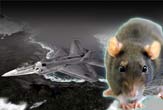Franken-Rodent! It's Alive! ALIVE ... ! (Well, kinda ...)

In his excellent 1999 novel Starfish, science fiction writer Peter Watts wrote about "cultured brains on a slab" - a "smart gel - that could pilot a plane as well as a person. Now, University of Florida biomedical engineer Dr. Thomas DeMarse has created a "brain in a dish" that can interact with a computer flight simulation.
The "brain" is a small puddle of 25,000 living neurons taken from a rat's brain and cultured in a glass dish.
"It's essentially a dish with 60 electrodes arranged in a grid at the bottom," DeMarse said. "Over that we put the living cortical neurons from rats, which rapidly begin to reconnect themselves, forming a living neural network - a brain."
The multi-electrode grill is connected to a personal computer running a flight simulation program. The individual neurons are distributed randomly at the beginning of the experiment, and are not connected. The aircraft simulation of an F-22 fighter jet feeds data into the grid about flight conditions; whether the plane is flying straight and level or not. The neurons begin to organize themselves, forming connections to each other. The neurons analyze the data and respond by sending signals to the plane's controls.
At first, the simulated plane drifts randomly. But the neural network slowly learns; currently, the brain can control the pitch and roll of the simulated craft in most weather conditions, including storms and hurricane-force winds.
"My precioussss ..." University of Florida researcher ThomasDeMarse holds a glass dish on October 12, 2004, containinga "brain" -- a living network of rat brain cells connectedto electrodes. Credit: UofF
DeMarse points out that, while computers have fast processing speeds, they can't approach the flexibility of the human brain. Certain kinds of computation, like pattern recognition, is difficult to program into a computer. Peter Watts points out this very same fact in his choice of living neurons as pilots:
Humans had always been able to integrate 3-D spatial information better than the machines that kept trying to replace them... Until now, apparently... (Read more from Starfish smart gels)
(This Science Fiction in the News story used with permission from Technovelgy.com - where science meets fiction.)
Get the world’s most fascinating discoveries delivered straight to your inbox.
